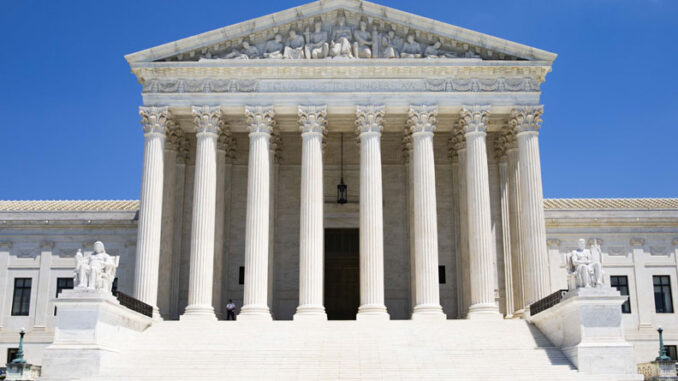
WASHINGTON, D.C. (TIP): The Supreme Court on Thursday, June 13, maintained access to a widely available abortion pill, rejecting a bid from a group of anti-abortion organizations and doctors to undo the Food and Drug Administration’s approval of the drug.
In a unanimous decision, written by Justice Brett M. Kavanaugh, the court held that the anti-abortion groups lacked a direct stake in the dispute, a requirement to challenge the F.D.A.’s approval of the pill, mifepristone.
“The plaintiffs do not prescribe or use mifepristone,” Justice Kavanaugh wrote. “And F.D.A. is not requiring them to do or refrain from doing anything.”
He added, “A plaintiff ’s desire to make a drug less available for others does not establish standing to sue.”
The case originally sought to erase the F.D.A.’s approval of mifepristone. But by the time it reached the Supreme Court, the question had been narrowed to whether the agency had acted legally in 2016 and 2021, when it broadened distribution of the pill, eventually including telemedicine and mail options.
The ruling handed a muted victory to abortion rights groups. Even as they praised the decision for averting severe restrictions on the availability of the pill, they warned that the outcome could be short-lived. Anti-abortion groups vowed to press ahead, promising that the fight was far from over and raising the possibility that other plaintiffs, states in particular, would mount challenges to the drug.
The ruling did not affect separate restrictions on the pill in more than a dozen states that have passed near-total bans on abortion since the court eliminated a constitutional right to the procedure in Dobbs v. Jackson Women’s Health Organization. (The bans do not distinguish between medication and surgical abortion.)
Access to abortion remains broadly popular, and ever since the court overturned Roe v. Wade two years ago, prompting some states to swiftly enact bans, the issue has been a major focus of political campaigns. Democrats have succeeded in galvanizing voters to defeat anti-abortion measures and plan to highlight abortion rights in the November elections.
By dodging a ruling on the substance of the case, the justices avoided delivering a clear, substantive win to either political party or a decision they could use to motivate their base.
President Biden said in a statement that the “decision does not change the fact that the fight for reproductive freedom continues.”
He added, “It does not change the fact that the Supreme Court overturned Roe v. Wade two years ago, and women lost a fundamental freedom.”
The Biden campaign also raised concerns that the ruling would not be enough to protect access to abortion medication if former President Donald J. Trump wins a second term, saying his administration would move to enforce new restrictions through executive action.
Mr. Trump had wrestled with what position to take on abortion access after the Supreme Court, whose conservative supermajority he appointed, overturned the Roe v. Wade landmark abortion-rights case. Several weeks ago, he said it was up to states to set their own policies.
His campaign suggested he staked out a similar position on the abortion pill ruling, without addressing how his administration would handle regulation of the drug. “The Supreme Court has unanimously decided 9-0; the matter is settled,” Danielle Alvarez, a Trump spokeswoman, said.
Abortion rights groups cautioned that the ruling only maintained the status quo.
“The anti-abortion movement sees how critical abortion pills are in this post-Roe world, and they are hell bent on cutting off access,” Nancy Northup, the president of the Center for Reproductive Rights, said in a statement.
Erin Hawley, senior counsel for Alliance Defending Freedom, the conservative legal organization that represented the plaintiffs, suggested that the case could be revived through three Republican-led states, Idaho, Kansas and Missouri, which had intervened as plaintiffs at the lower court level.
“We are grateful that three states stand ready to hold the F.D.A. accountable for jeopardizing the health and safety of women and girls across this country,” Ms. Hawley said in a statement.
Mifepristone, part of a two-drug regimen, is used in nearly two-thirds of abortions in the United States. Many studies have found the pill to be safe, and years of research have shown that serious complications are rare.
After the F.D.A. loosened restrictions on the drug’s availability during the pandemic, allowing for it to be prescribed online or sent by mail, its use only increased. A rising number of medication abortions are prescribed by telemedicine. By one count, about one in six abortions, or around 14,000 a month, happened via telehealth from July through September 2023.
Medication abortion has become a practical form of abortion for women in states where the procedure is banned. Clinicians, protected by so-called shield laws in several states where abortion is legal, have mailed pills to women based in states with bans.
Justice Kavanaugh focused part of the majority opinion on why the justices disagreed with rulings by lower courts, which all determined the groups had standing to bring the case.
Citing Justice Antonin Scalia, Justice Kavanaugh wrote that to bring a suit, a plaintiff first must answer a basic question: “What’s it to you?”
Plaintiffs must show “a predictable chain of events leading from the government action to the asserted injury,” Justice Kavanaugh wrote.
In this instance, he wrote, the doctors and medical associations trying to challenge F.D.A.’s regulation failed to show an actual injury because the plaintiffs did not include people actually involved with the pill, such as doctors who prescribed mifepristone or pregnant women who took it.
The plaintiffs’ claims that they have “sincere legal, moral, ideological, and policy objections to mifepristone being prescribed and used by others” do not meet the threshold of standing to sue, Justice Kavanaugh wrote.
The justices also rejected an argument by the anti-abortion doctors that they had standing to sue because they could be required to provide emergency abortions against their conscience.
Federal conscience laws already protect doctors from being required to perform abortions or other treatment that violates their consciences, and none of the doctors had shown otherwise, Justice Kavanaugh wrote.
In a concurring opinion, Justice Clarence Thomas noted that he supported the decision “in full,” but cautioned that the court should take a limited view of when to allow organizations to claim standing on behalf of their members.
The case returned the issue of abortion to the Supreme Court, even as the conservative majority had declared, in overturning Roe v. Wade, that it would cede the question of access “to the people and their elected representatives.”
Its decision on Thursday appeared to vindicate that promise, although the court will soon decide another major case on abortion, involving a clash between federal law and tightened state restrictions.
The abortion pill case, F.D.A. v. Alliance for Hippocratic Medicine, reflected a new front in the fierce fight over abortion.
In the fall of 2022, an umbrella group of anti-abortion medical organizations, along with several doctors, challenged the F.D.A.’s approval of mifepristone more than two decades ago. In a preliminary ruling, a federal judge in Texas, Matthew J. Kacsmaryk, said that the F.D.A.’s approval of the drug should be suspended, removing mifepristone from the market.
Judge Kacsmaryk, a Trump appointee, joined the federal bench after years litigating at a conservative religious freedom firm, First Liberty Institute.
An appeals court, in New Orleans, overturned the part of Judge Kacsmaryk’s ruling that invalidated the F.D.A.’s approval of the pill, but it imposed certain restrictions on its distribution. Those restrictions included prohibiting the medication from being sent by mail or prescribed by telemedicine.
(Source: New York Times)





Be the first to comment